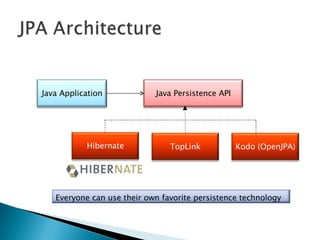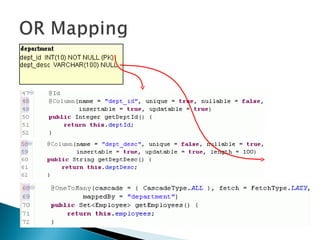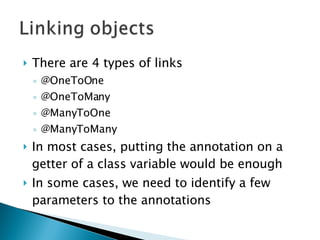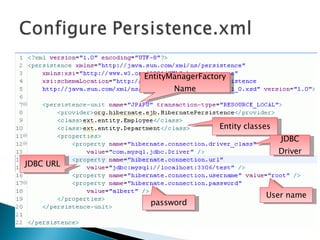Java Persistence API (JPA) Step By Step
- 2. What is Java Persistence API Primary Features Five Steps to Implement JPA Download Hibernate Components Prepare Database, and Download JDBC Driver Implemented POJO entities and add annotations Persistence.xml Implemented client side code via EntityManager
- 3. The Java Persistence API is the standard object/relational mapping and persistence management interface of the Java EE 5.0 platform. As part of the EJB 3.0 specification effort, it is supported by all major vendors of the Java industry.
- 4. Inheritance, polymorphism, etc. Using annotations and/or XML
- 5. Java Application Java Persistence API Hibernate TopLink Kodo (OpenJPA) Everyone can use their own favorite persistence technology
- 6. Hibernate Core Hibernate Annotation (JPA) Hibernate EntityManager Hibernate Annotation (Hibernate) Hibernate XML Mapping File Java Persistence API Hibernate API
- 7. 1. Hibernate Core 2. Hibernate EntityManager 3. Hibernate Annotations http://www.hibernate.org/ MySQL JDBC Driver http://tinyurl.com/ymt6rb
- 8. 1. Hibernate Core 2. Hibernate EntityManager 3. Hibernate Annotations http://www.hibernate.org/ MySQL JDBC Driver http://tinyurl.com/ymt6rb
- 9. To label artifacts (classes, methods etc.) for persistence or persistence related operations A “gateway” to the persistence classes Allow access to persistent objects, transaction context, query language etc.
- 10. Hibernate Annotations includes Standardized Java Persistence and EJB 3.0 (JSR 220) object/relational mapping annotations Hibernate-specific extension annotations for performance optimization and special mappings Hibernate EntityManager includes The standard Java Persistence management API The standard Java Persistence Query Language The standard Java Persistence object lifecycle rules The standard Java Persistence configuration and packaging
- 11. 1. Hibernate Core 2. Hibernate EntityManager 3. Hibernate Annotations http://www.hibernate.org/ MySQL JDBC Driver http://tinyurl.com/ymt6rb
- 14. Attached to a class Signify that a class is persistent Example: An entity must follow the Java Bean convention for its attributes to be persistent Having getters and setters
- 15. Each entity must have an identity An identity of an entity could simply be a class variable annotated with @Id Example
- 16. Id can be auto generated @Id(generate=GeneratorType.AUTO) There are other strategies such as GeneratorType.SEQUENCE GeneratorType.IDENTITY AUTO is best for portability between database vendors
- 17. @Column, is put on getter of a class variable Has several functionalities Updatable (boolean) Nullable (updatable) Length (int) Example:
- 18. There are 4 types of links @OneToOne @OneToMany @ManyToOne @ManyToMany In most cases, putting the annotation on a getter of a class variable would be enough In some cases, we need to identify a few parameters to the annotations
- 19. Two cases Two entities share the same primary key value
- 20. Entity objects have two distinct modes Attached The object is in the database Detached The object is in memory acting as a DTO Modification on detached object would not be persisted automatically Developers need to persist detached objects using a primitive
- 21. Entity manager: Gateway to persistent classes Enable queries Outside of session beans, provides transaction facility
- 22. 1. Hibernate Core 2. Hibernate EntityManager 3. Hibernate Annotations http://www.hibernate.org/ MySQL JDBC Driver http://tinyurl.com/ymt6rb
- 23. Entity classes JDBC Driver JDBC URL User name password EntityManagerFactory Name
- 24. 1. Hibernate Core 2. Hibernate EntityManager 3. Hibernate Annotations http://www.hibernate.org/ MySQL JDBC Driver http://tinyurl.com/ymt6rb
- 25. Create Create Operates Persistence.xml

![Albert Guo [email_address]](https://image.slidesharecdn.com/java-persistence-api-jpa-step-by-step-1219989536163941-9/85/Java-Persistence-API-JPA-Step-By-Step-1-320.jpg)



























